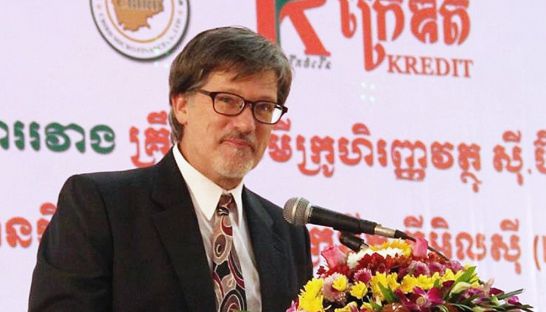Finance sector in the spotlight
Finance sector in the spotlight
Cambodia's financial sector and the Cambodian people’s appetite for financial products is growing exponentially. In September, the Credit Bureau of Cambodia released its first ever credit outlook. It stated that microfinance institutions (MFIs) are expected to increase existing portfolios from 1.5 million accounts by 159 per cent over the next six years. Tim Amstutz, chairman of the board for KREDIT MFI Cambodia, one of the many microfinance firms operating here, spoke with the Post’s May Kunmakara about the prospect and performance of the financial sector.

What is your outlook on Cambodia’s financial industry?
In the near term, I see continued accelerated growth in the financial services sector, both in terms of scope and reach of the industry, as well as in the range of financial products available to the public. However, the longer term outlook is uncertain. The recent uninterrupted and rapid growth in the both the banking and MFI sectors will most likely face a season of
self-correction.
It seems to me that there are too many small MFIs that risk marring the reputation of the MFI industry. In your point of view, do the smaller MFIs merge with each other?
I believe the real risk is not the number of new MFI’s, but rather their mission and motives. Almost all of the new players have been set up by wealthy investors who may not share the same original mission of microfinance which is to lift the poor out of poverty. To date, the only merger that has occurred within the MFI sector has been the merger of KREDIT MFI, of which I am board chair, with CBIRD, a smaller MFI based in Battambang province.
Most MFIs’ source of funds are from foreign partners which makes interest rates high, leading to a low demand for loans. What can the sector do to lower the interest rate?
While it is true that foreign investors provide the largest source of funds for MFIs, I would not agree that this has reduced the demand for loans. The continued dramatic increase in both the number of clients served and the loan portfolios of the major MFIs is enough evidence that demand is still high. The trend in lending rates over recent years has been a slow and steady decline.
What are your thoughts on the trends you’ve witnessed in MFIs and what trends do you think we will see?
I think the major trend that we will see, which is already happening at the moment, is an increased convergence of the MFI and banking sectors. The defining lines between banks and MFI’s are being blurred as MFI’s continue to move up-market and function more like banks, driven by a desire for increased
profitability.
At present, Cambodia has only seven MFIs that receive deposits from the public while the demand for loans is still on the rise. Will the imbalance between loans and deposits expose MFIs to risks in the upcoming years? If so, what can be done to reduce this?
Yes, this is definitely a risk. However, it is useful to note two counterbalancing dynamics which help to mitigate some of the risks: 1) These few MFI’s that are authorised to take deposits, including my MFI, KREDIT, are also the largest MFI’s who serve the vast majority of small borrowers in Cambodia. 2) MFI’s have only in recent years been authorised to take deposits, yet the amount of funds on deposit with these few institutions has increased very rapidly and is now quite substantial, by more competitive interest rates than commercial banks are able to offer.
phnompenh post













